Greenwich: Difference between revisions
m clean up, typos fixed: the the → the |
|||
| Line 132: | Line 132: | ||
==Transport== | ==Transport== | ||
Two railway lines cross Greenwich:<ref>{{Cite web|url=http://www.greenwich.gov.uk/Greenwich/Travel/ |title=Greenwich Council - Travel & transport - Travel |publisher=www.greenwich.gov.uk |accessdate=2009-09-24 }}</ref> the Greenwich Line, which runs west to east and follows the route of the London and Greenwich Railway, which was the first railway line into [[London]],<ref>{{Cite web|url=http://www.yellins.com/transporthistory/rail/l-and-g.html |title=London and Greenwich Railway |publisher=www.yellins.com |accessdate=2009-09-24 }}</ref><ref>{{Cite book|url=http://books.google.com/books?id=A2RCAAAAIAAJ&pg=PA237&dq=London+and+Greenwich+Railway&as_brr=3&client=firefox-a#v=onepage&q=London%20and%20Greenwich%20Railway&f=false |title=A history of the English railway ... - Google Books |publisher=books.google.com |accessdate=2009-09-24 }}</ref> and links the South Eastern Main Line with the North Kent Line at Charlton; and the Docklands Light Railway (DLR), which runs north to south. Both lines are served by Greenwich station; with the DLR having a separate station at Cutty Sark DLR Station near the river, and the Greenwich Line having Maze Hill railway station to the east, on the boundary with Westcombe Park. DLR trains run from [[Lewisham]] to Bank and [[Stratford, Essex|Stratford]] by way of Canary Wharf. The Greenwich Line carries trains from London Charing Cross and London Cannon Street in central London to [[Dartford]], with a limited service to [[Gravesend]] and [[Gillingham, Kent]]. There are no [[London Underground]] stations in Greenwich itself; North Greenwich tube station on the Greenwich Peninsula is the nearest tube station. | Two railway lines cross Greenwich:<ref>{{Cite web|url=http://www.greenwich.gov.uk/Greenwich/Travel/ |title=Greenwich Council - Travel & transport - Travel |publisher=www.greenwich.gov.uk |accessdate=2009-09-24 }}</ref> the Greenwich Line, which runs west to east and follows the route of the London and Greenwich Railway, which was the first railway line into [[London]],<ref>{{Cite web|url=http://www.yellins.com/transporthistory/rail/l-and-g.html |title=London and Greenwich Railway |publisher=www.yellins.com |accessdate=2009-09-24 }}</ref><ref>{{Cite book|url=http://books.google.com/books?id=A2RCAAAAIAAJ&pg=PA237&dq=London+and+Greenwich+Railway&as_brr=3&client=firefox-a#v=onepage&q=London%20and%20Greenwich%20Railway&f=false |title=A history of the English railway ... - Google Books |publisher=books.google.com |accessdate=2009-09-24 }}</ref> and links the South Eastern Main Line with the North Kent Line at Charlton; and the [[Docklands Light Railway]] (DLR), which runs north to south. Both lines are served by Greenwich station; with the DLR having a separate station at Cutty Sark DLR Station near the river, and the Greenwich Line having Maze Hill railway station to the east, on the boundary with Westcombe Park. DLR trains run from [[Lewisham]] to Bank and [[Stratford, Essex|Stratford]] by way of Canary Wharf. The Greenwich Line carries trains from London Charing Cross and London Cannon Street in central London to [[Dartford]], with a limited service to [[Gravesend]] and [[Gillingham, Kent]]. There are no [[London Underground]] stations in Greenwich itself; North Greenwich tube station on the Greenwich Peninsula is the nearest tube station. | ||
There are a number of river boat services running from Greenwich Pier, managed by London River Services. The main services include the Thames commuter catamaran service run by Thames Clipper from Embankment, by way of Tower Millennium Pier, Canary Wharf and on to the O2 (London)|O<sub>2</sub> and Woolwich Arsenal Pier;<ref>{{Cite web|url=http://www.greenwich.gov.uk/Greenwich/Travel/LocalTravelServices/ThamesClipper.htm |title=Greenwich Council - Local travel services - Thames Clipper |publisher=www.greenwich.gov.uk |accessdate=2009-09-24 }}</ref> the Wesminster-Greenwich cruise service by Thames River Services; and the City Cruises tourist cruise via Westminster, Waterloo and Tower piers.<ref>{{Cite web|url=http://www.greenwich.gov.uk/Greenwich/Travel/LocalTravelServices/RiverBoatCruise.htm |title=Greenwich Council - Local travel services - River boat cruises |publisher=www.greenwich.gov.uk |accessdate=2009-09-24 }}</ref> | There are a number of river boat services running from Greenwich Pier, managed by London River Services. The main services include the Thames commuter catamaran service run by Thames Clipper from Embankment, by way of Tower Millennium Pier, Canary Wharf and on to the O2 (London)|O<sub>2</sub> and Woolwich Arsenal Pier;<ref>{{Cite web|url=http://www.greenwich.gov.uk/Greenwich/Travel/LocalTravelServices/ThamesClipper.htm |title=Greenwich Council - Local travel services - Thames Clipper |publisher=www.greenwich.gov.uk |accessdate=2009-09-24 }}</ref> the Wesminster-Greenwich cruise service by Thames River Services; and the City Cruises tourist cruise via Westminster, Waterloo and Tower piers.<ref>{{Cite web|url=http://www.greenwich.gov.uk/Greenwich/Travel/LocalTravelServices/RiverBoatCruise.htm |title=Greenwich Council - Local travel services - River boat cruises |publisher=www.greenwich.gov.uk |accessdate=2009-09-24 }}</ref> | ||
Latest revision as of 11:40, 28 May 2016
| Greenwich | |
| Kent | |
|---|---|
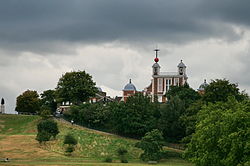 Royal Observatory, Greenwich | |
| Location | |
| Grid reference: | TQ395775 |
| Location: | 51°28’45"N, -0°0’0"E |
| Data | |
| Post town: | London |
| Postcode: | SE10 |
| Dialling code: | 020 |
| Local Government | |
| Council: | Greenwich |
| Parliamentary constituency: |
Greenwich and Woolwich |
Greenwich is a town in Kent on the River Thames, famous for seafaring and its naval tradition.
Greenwich is best known for its maritime history and for giving its name to the Greenwich Meridian (0° longitude) and from it Greenwich Mean Time. The town became the site of a Royal palace, the Palace of Placentia from the 15th century, and was the birthplace of many in the House of Tudor, including Henry VIII and Elizabeth I. The palace fell into disrepair during the English Civil War and was rebuilt as the Royal Naval Hospital for Sailors by Sir Christopher Wren and his assistant Nicholas Hawksmoor. These buildings became the Royal Naval College in 1873, and they remained an establishment for military education until 1998 when they passed into the hands of the Greenwich Foundation. The historic rooms within these buildings remain open to the public; other buildings are used by University of Greenwich and the Trinity College of Music.
The town has a popular, bustling town centre, catering for its many visitors and filled with remembrances of its naval history. Above the town centre, Greenwich Park spreads up the hill, a popular place of resort and also the location of Royal Greenwich Observatory and National Maritime Museum.
The town became a popular resort in the 17th century with many grand houses, such as Vanbrugh castle established on Maze Hill, next to the park. From the Georgian period estates of houses were built above the town centre. The maritime connections of Greenwich were celebrated in the 20th century, with the sitting of the Cutty Sark and Gipsy Moth IV next to the river front, and the National Maritime Museum in the former buildings of the Royal Hospital School in 1934.
Name of the town
The Old English name Grenewic means the green village or the village on the green.[1] It became known as East Greenwich to distinguish it from West Greenwich or Deptford Strond, the part of Deptford adjacent to the Thames,[2] but the use of East Greenwich to mean the whole of the town of Greenwich died out in the 19th century.
However, Greenwich was divided into the two Poor Law Unions of Greenwich East and Greenwich West from the beginning of Civil registration in 1837, the boundary running down what is now Greenwich Church Street and Crooms Hill, although more modern references to "East" and "West" Greenwich probably refer to a natural division either side of the vast expanse of the Royal Naval College and National Maritime Museum. An article in The Times of 13 October 1967 stated:
- East Greenwich, gateway to the Blackwall Tunnel, remains solidly working class, the manpower for one eighth of London's heavy industry. West Greenwich is a hybrid: the spirit of Nelson, the Cutty Sark, the Maritime Museum, an industrial waterfront and a number of elegant houses, ripe for development.[3]
History
Early remains
Tumuli to the south-west of Flamsteed House in Greenwich Park, are thought to be early Bronze Age barrows re-used in the Anglo-Saxon period, in the 6th century, as burial grounds. To the east between the Vanbrugh and Maze Hill Gates is the site of a Roman villa or temple. A small area of red paving tesserae protected by railings marks the spot. It was excavated in 1902 and 300 coins were found dating from the emperors Claudius and Honorius to the 4th century. This was excavated by the Time Team for Channel 4.
The Roman road from London to Dover, Watling Street, crossed the high ground to the south of Greenwich, through Blackheath. This followed the line of an earlier pre-Roman route from Canterbury to St Albans.[4] As late as the days of King Henry V, Greenwich was only a fishing town, with a safe anchorage in the river.[2]
Alphege and the Danes
During the reign of Ethelred the Unready, the Danish fleet anchored in the river Thames off Greenwich for over three years, with the army being encamped on the hill above. From here they attacked Kent, and in the year 1012, took the city of Canterbury, making Alphege the Archbishop their prisoner for seven months in their camp at Greenwich. They stoned him to death for his refusal to allow his ransom to be paid (3,000 pieces of silver) and, according to legend, the Danes kept his body until the blossoming of a stick that had been immersed in his blood. For this miracle his body was released to his followers, he was hailed as a saint for his martyrdom, and in the 12th century the parish church was dedicated to him. The present church on the site west of the town centre is St Alfege's Church, designed by Nicholas Hawksmoor in 1714 and completed in 1718.
Royal Greenwich
The Domesday Book records the manor of Greenwich as held by the Bishop Odo of Bayeux; his lands were seized by the crown in 1082. A royal palace, or hunting lodge, has existed here since before 1300, when Edward I is known to have made offerings at the chapel of the Virgin Mary.[1] Subsequent monarchs were regular visitors; Henry IV made his will here, and Henry V granted the manor to Thomas Beaufort, Duke of Exeter for lifetime. Beaufort died at Greenwich in 1417. The palace was created by Humphrey, Duke of Gloucester, the regent to Henry VI in 1447; enclosing the park and erecting a tower on the spot of the Royal Observatory. It was renamed the Palace of Placentia or Pleasaunce by Henry VI's consort Margaret of Anjou after Humphrey's death. The palace was completed and further enlarged by Edward IV, and in 1466 it was granted to his Queen, Elizabeth.[1]
The palace was the principal residence of Henry VII, and his sons, Henry (later Henry VIII) and Edmund Tudor were born here, and baptised in St Alphege's. Henry favoured Greenwich over nearby Eltham Palace, the former principal royal palace. Both Mary and Elizabeth were born at Greenwich (on 18 February 1516 and 7 September 1533 respectively). The palace of Placentia, in turn, became Elizabeth's favourite summer residence.[1]
During the English Civil War, the palace was used as a biscuit factory and prisoner of war camp, then after the King was beheaded the palace and park were seized to become a 'mansion' for the Lord Protector. By the Restoration in 1660, the Palace of Placentia had fallen into disuse and was pulled down. New buildings began to be established as a grand palace for Charles II, but only the King Charles block was completed. It was suggested that the buildings be adapted for a Greenwich Hospital, designed by Wren, and later completed by Hawksmoor. Queen Anne had a house built by Inigo Jones on the hill above, now overlooking the hospital and river - the present centrepiece of the National Maritime Museum,[1] founded in 1934 and housed in the buildings of the former Royal Hospital School.
Flamsteed House was designed and built by Sir Christopher Wren in 1675-76. It was the home of the first Astronomer Royal John Flamsteed and the heart of Charles II's new Royal Observatory.
All these buildings, the palace, naval college and hospital, have been parted from their functions, but these and the Royal Observatory form the core of the World Historic Site.
The effective royal association with Greenwich has now ended, though The Queen has agreed that he borough bearing the town's name will be entitled to be named a "Royal Borough" from Her Majesty's diamond jubiliee in 2012.
Geography
Topography
The town of Greenwich is built on a broad platform to the south of the outside of a broad meander in the River Thames, with a safe deep water anchorage lying in the river. To the south, the land rises steeply, 100 feet through Greenwich Park to the town of Blackheath. The higher areas consist of a sedimentary layer of gravely soils, known as the Blackheath Beds, that spread through much of the south east over a chalk outcrop – with sands, loam and seams of clay at the lower levels by the river.
Greenwich is bordered by Deptford Creek and Deptford to the west; the former industrial centre of the Greenwich Peninsula, and the residential area of Westcombe Park to the east. The River Thames wets its north shore, while Blackheath Common bounds the south.

Sites of interest
Riverfront
The Cutty Sark (a clipper ship) has been preserved in a dry dock by the river. A major fire in May 2007 destroyed a part of the ship, although much had already been removed for restoration. Nearby for many years was also displayed Gipsy Moth IV, the 54 foot yacht sailed by Sir Francis Chichester in his single-handed, 226-day circumnavigation of the globe during 1966–67. In 2004, Gipsy Moth IV was removed from Greenwich, and after restoration work completed a second circumnavigation in May 2007. On the riverside in front of the north-west corner of the Hospital is an obelisk erected in memory of Arctic explorer Joseph René Bellot.
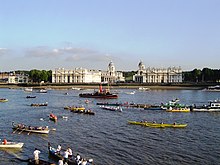
Near the Cutty Sark site, a circular building contains the entrance to the Greenwich foot tunnel, opened on 4 August 1902, which runs beneath the Thames and connects Greenwich to the Isle of Dogs on the Middlesex bank. The north exit of the tunnel is at Island Gardens,[5] from where the famous view of Greenwich Hospital painted by Canaletto can be seen.
Rowing has been part of life on the river at Greenwich for hundreds of years and the first Greenwich Regatta was held in 1785. The annual Great River Race along the Thames Tideway finishes at the Cutty Sark. The Trafalgar Rowing Centre in Crane Street close by is home to Curlew Rowing Club and Globe Rowing Club.
The Old Royal Naval College is Sir Christopher Wren's domed masterpiece at the centre of the heritage site. The site is administered by the Greenwich Foundation and several of the buildings are let to the University of Greenwich and one, the King Charles block, to Trinity College of Music. Within the complex is the former college dining room, the Painted Hall, a room highly decorated in celebration of the Navy, painted by James Thornhill.
At the time the College was sold in 1996, Admiral of the Fleet Lord Lewin addressed 350 people in the Painted Hall for what appeared to be the last Trafalgar night party, and said:
| “ | There are only two places to be on Trafalgar night - in Nelson's cabin in HMS Victory or in the Painted Hall.[6] | ” |
The holding of the Trafalgar Night Dinner in the Painted Hall has however been maintained by the Greenwich Foundation.
The Chapel of St Peter and St Paul is opposite the Painted Hall. It has an interior designed by James 'Athenian' Stuart, with a vast painting of St Paul escaping shipwreck at Malta. The lectern bible is left open at that passage.
The Naval College had a training nuclear reactor, the JASON reactor, within the King William building that was operational between 1962 and 1996. The reactor was decommissioned and removed in 1999.[7]
To the east of the Naval College is the Trinity Hospital almshouse, founded in 1613, the oldest surviving building in the town centre.[8] This is next to the massive brick walls and the landing stage of Greenwich Power Station. Built between 1902 and 1910 as a coal-fired station to supply power to London's tram system, and later the London Underground, it is now oil- and gas-powered and serves as a backup station for London Underground.[9] East Greenwich also has a small park, East Greenwich Pleasaunce, which was formerly the burial ground of Greenwich Hospital.
The O2 (formerly the Millennium Dome) was built on a disused British Gas site on the Greenwich Peninsula.[10] It is next to North Greenwich tube station, about 3 miles east of Greenwich town centre. The Greenwich Millennium Village is a new urban regeneration development to the south of the Dome.
Greenwich Park
Behind the former Naval College is the National Maritime Museum housed in buildings forming another symmetrical group and grand arcade around the Queen's House, designed by Inigo Jones. Continuing to the south, Greenwich Park is a Royal Park of 183 acres, laid out in the 17th century and formed from the hunting grounds of the Royal Palace of Placentia.[11]
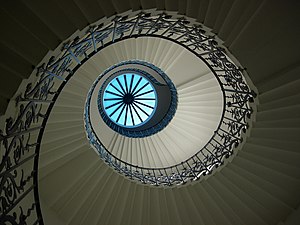
The park rises towards Blackheath and at the top of this hill is a statue of James Wolfe, commander of the British expedition which captured Quebec,[12] nearby a major group of buildings within the park is the former Royal Observatory, Greenwich through which the Greenwich Meridian passes and indeed by which the Meridian is defined. While Greenwich no longer hosts a working astronomical observatory, a time ball still drops daily to mark the exact moment of 1 p.m., and there is a museum of astronomical and navigational tools, particularly John Harrison's marine chronometers.[13]
The Ranger's House lies at the Blackheath end of the park and houses the Wernher Collection of art,[14] and many fine houses, including Vanbrugh's house lie on Maze Hill, on the western edge of the park.
Town centre
Georgian and Victorian architecture dominates in the town centre which spreads to the west of the park and Royal Naval College. Much of this forms a one-way system around a covered market, Greenwich Market and the arthouse Greenwich Cinema. Up the hill, from the centre there are many streets of Georgian houses, including the world's only museum dedicated to fans, the Fan Museum, on Croom's Hill. Nearby at the junction of Croom's Hill with Nevada Street, is Greenwich Theatre, formerly Crowder's Music Hall - one of two Greenwich theatres, the other being the Greenwich Playhouse.
Greenwich Mean Time
- Main article: Greenwich Meridian
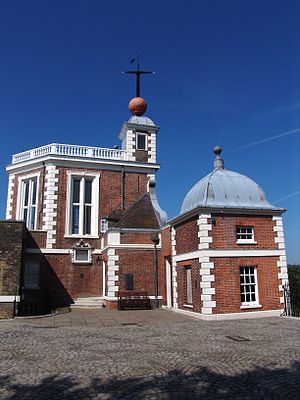
Greenwich Mean Time (GMT) is a term originally referring to mean solar time at the Royal Observatory in Greenwich. It is commonly used in practice to refer to the time zone using "Coordinated Universal Time" (UTC).[15] It is also used to refer to "Universal Time", which is a standard astronomical concept used in many technical fields and is referred to by the navy as "Zulu".
As the United Kingdom grew into an advanced maritime nation, British mariners kept at least one chronometer on GMT in order to calculate their longitude from the Greenwich meridian, which was by convention considered to be the prime meridian from which all longitudes would be measured in degrees west or east. Shipboard time was still solar time for the location of the ship, and the difference between noon locally and the time in Greenwich would tell the ship's exact longitude.
Thus British seacharts were marked with all longitudes measured from Greenwich and as British charts came to be adopted by the majority of the world's shipping, they defined the standard. The International Meridian Conference of 1884 eventually adopted the Greenwich Meridian as the standard prime meridian of the world. Likewise Greenwich Mean Time became adopted worldwide as a reference time independent of location and time zones were based upon this reference as a number of hours and half-hours "ahead of GMT" or "behind GMT".
In recognition of the town's astronomical links, Asteroid 2830 has been named 'Greenwich'.[16]
World heritage site
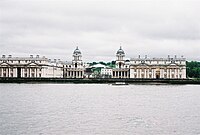
In 1997, Maritime Greenwich was added to the list of World Heritage Sites, for the concentration and quality of buildings of historic and architectural interest. These can be divided into the group of buildings along the riverfront, Greenwich park and the Georgian and Victorian town centre.
Discover Greenwich Visitor Centre
The Discover Greenwich Visitor Centre provides an introduction to the history and attractions in the Greenwich World Heritage Site. It is located in the Pepys Buildings near to the Cutty Sark within the grounds of the Old Royal Naval College, (formerly Greenwich Hospital). The centre opened in March, 2010, and admission is free.[17]
The Centre explains the history of Greenwich as a royal residence and a maritime centre.
Economy
The market
There has been a market at Greenwich since the 14th century, but the history of the present market dates from 1700 when a charter to run two markets, on Wednesdays and Saturdays, was assigned by Lord Romney to the Commissioners of Greenwich Hospital for 1000 years.
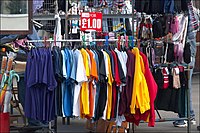
Greenwich Market sits in Greenwich town centre within an area called the Island Site, which is bounded by College Approach, Greenwich Church Street, King William Walk and Nelson Road. The Island site forms part of the World Heritage Site, which also includes the National Maritime Museum, Royal Naval College, the Queens House and the Royal Observatory.
The buildings surrounding the market on the island site are Grade 2 listed, and were established in 1827-1833 under the direction of Joseph Kay. Later significant phases of development occurred in 1902-8; in 1958-60 and during the 1980s. The current market roof dates from 1902–08 and the buildings on either side of the market from 1958-60.
Greenwich Market trades five days a week, being closed on Monday and Tuesday, but the shops, cafes, bars, pubs and restaurants around the Market are open seven days a week, including Greenwich Printmakers, the oldest-established printmaking co-operative in Britain.
Wednesday is a food and homewares market day, Thursdays and Fridays specialise in antiques and collectibles and arts and crafts. Weekends and bank holidays attract arts & crafts and food stalls.There are a wide selection of specialist shops, bars, restaurants and a café, all open seven days a week.
Plans to redevelop the market by its owners, Greenwich Hospital,[18] were unanimously rejected by Greenwich Council's Planning Board in August 2009.
Transport
Two railway lines cross Greenwich:[19] the Greenwich Line, which runs west to east and follows the route of the London and Greenwich Railway, which was the first railway line into London,[20][21] and links the South Eastern Main Line with the North Kent Line at Charlton; and the Docklands Light Railway (DLR), which runs north to south. Both lines are served by Greenwich station; with the DLR having a separate station at Cutty Sark DLR Station near the river, and the Greenwich Line having Maze Hill railway station to the east, on the boundary with Westcombe Park. DLR trains run from Lewisham to Bank and Stratford by way of Canary Wharf. The Greenwich Line carries trains from London Charing Cross and London Cannon Street in central London to Dartford, with a limited service to Gravesend and Gillingham, Kent. There are no London Underground stations in Greenwich itself; North Greenwich tube station on the Greenwich Peninsula is the nearest tube station.
There are a number of river boat services running from Greenwich Pier, managed by London River Services. The main services include the Thames commuter catamaran service run by Thames Clipper from Embankment, by way of Tower Millennium Pier, Canary Wharf and on to the O2 (London)|O2 and Woolwich Arsenal Pier;[22] the Wesminster-Greenwich cruise service by Thames River Services; and the City Cruises tourist cruise via Westminster, Waterloo and Tower piers.[23]
Pedestrian and cyclists
The Thames Path National Trail runs along the riverside.[24] The Greenwich foot tunnel provides pedestrian access to the southern end of the Isle of Dogs, across the river Thames.
National Cycle Network route 1 runs through the foot tunnel (although cycles must not be ridden in the tunnel itself).[25]
References
- ↑ 1.0 1.1 1.2 1.3 1.4 'Greenwich', The Environs of London: volume 4: Counties of Herts, Essex & Kent (1796), pp. 426-93 accessed: 26 May 2007
- ↑ 2.0 2.1 Parishes: Greenwich, The History and Topographical Survey of the County of Kent: Volume 1 (1797), pp. 372-420
- ↑ "Greenwich-the instant village", Brandon Green, The Times, 13 October 1967; pg. 11
- ↑ The Roman Watling Street: from London to High Cross O. Roucoux, (Dunstable Museum Trust, 1984) ISBN 0-9508406-2-9
- ↑ The Foot Tunnel (Greenwich Guide) accessed 10 December 2007
- ↑ The Times 26 October 1996
- ↑ Just another source of neutrons? R.J.S. Lockwood and Prof. P.A. Beeley (Nuclear Dept., HMS Sultan, Gosport, 2001) accessed 29 December 2007
- ↑ Trinity Hospital
- ↑ Greenwich Power Station (Powering the City) accessed 10 December 2007
- ↑ East Greenwich Gasworks (Powering the City) accessed 10 December 2007. The Greenwich Peninsula gas works, being themselves notable, as being the subject of an IRA bomb attack in the 1970s, in which one gasometer and its contents were destroyed.
- ↑ Greenwich and Blackheath Past Felix Barker (Historical Publications Ltd., 1999) ISBN 0 948667 55 9
- ↑ General Wolfe Statue (Greenwich Guide) accessed 10 December 2007
- ↑ Greenwich Time and the Longitude Derek Howse (London: Philip Wilson, 1997) ISBN 0-85667-468-0
- ↑ The Wernher Collection (Ranger's House) (English Heritage) accessed 10 December 2007
- ↑ What is GMT? at the BBC Radio World Service
- ↑ Dictionary of Minor Planet Names Lutz D. Schmadel (Springer 2003) ISBN 3540002383
- ↑ "Greenwich Discover Greenwich Visitor Centre at Old Royal Naval College". wwww.oldroyalnavalcollege.org. http://www.oldroyalnavalcollege.org/discover-greenwich/. Retrieved 2010-06-03.
- ↑ "- Greenwich Market Consultation". www.greenwichmarketconsultation.org.uk. http://www.greenwichmarketconsultation.org.uk/. Retrieved 2009-09-18.
- ↑ "Greenwich Council - Travel & transport - Travel". www.greenwich.gov.uk. http://www.greenwich.gov.uk/Greenwich/Travel/. Retrieved 2009-09-24.
- ↑ "London and Greenwich Railway". www.yellins.com. http://www.yellins.com/transporthistory/rail/l-and-g.html. Retrieved 2009-09-24.
- ↑ A history of the English railway ... - Google Books. books.google.com. http://books.google.com/books?id=A2RCAAAAIAAJ&pg=PA237&dq=London+and+Greenwich+Railway&as_brr=3&client=firefox-a#v=onepage&q=London%20and%20Greenwich%20Railway&f=false. Retrieved 2009-09-24.
- ↑ "Greenwich Council - Local travel services - Thames Clipper". www.greenwich.gov.uk. http://www.greenwich.gov.uk/Greenwich/Travel/LocalTravelServices/ThamesClipper.htm. Retrieved 2009-09-24.
- ↑ "Greenwich Council - Local travel services - River boat cruises". www.greenwich.gov.uk. http://www.greenwich.gov.uk/Greenwich/Travel/LocalTravelServices/RiverBoatCruise.htm. Retrieved 2009-09-24.
- ↑ "The Thames Path - Greenwich to the London Eye". www.thames-path.org.uk. http://www.thames-path.org.uk/thames_greenwich_eye.html. Retrieved 2009-09-24.
- ↑ "National Cycle Network in London". Sustrans. http://www.sustrans.org.uk/sustrans-near-you/london/ncn-in-london. Retrieved 2009-09-24.
Outside links
| ("Wikimedia Commons" has material about Greenwich) |
- All Things Greenwich - a guide to local shops, services, restaurants, bars & pubs in Greenwich
- Greenwich World Heritage Site
- 'Greenwich', The Environs of London: volume 4: Counties of Herts, Essex & Kent (1796), pp. 426-93
